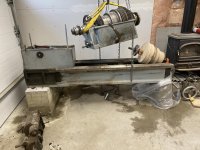I'm attemping to revive old lath.
Its a 1920 (ish) Amercian Tool Works, tool room lathe, 16"
Its ways are worn out too much for metal use.
So its being converted to a patternlathe, for wood working
The spindle however has some scouring on it.
When I spin it by hand, it goes for about 1/2 a rotation before stopping.
I pulled off the bearing tops and found some significan scouring on the spindle.


The bushings are plain bronze and appear to be in good shape.
Since I have only one big lathe...
How could I polish these up?
(I've called around for a mchinist to do it, but have been quote more than I paid for the entire lathe.
Any advice is greatly appreciated.
Olaf
Its a 1920 (ish) Amercian Tool Works, tool room lathe, 16"
Its ways are worn out too much for metal use.
So its being converted to a patternlathe, for wood working
The spindle however has some scouring on it.
When I spin it by hand, it goes for about 1/2 a rotation before stopping.
I pulled off the bearing tops and found some significan scouring on the spindle.


The bushings are plain bronze and appear to be in good shape.
Since I have only one big lathe...

How could I polish these up?
(I've called around for a mchinist to do it, but have been quote more than I paid for the entire lathe.
Any advice is greatly appreciated.
Olaf




 The large, long journals will take a lot of abuse before the spindle starts moving around alot- the machine won't be tight but it will do good work nontheless- even on demanding cuts. I did a bit of wood on mine, slightly oversped to about 400rpm, which is plenty fast with a 12" chuck whizzing around. Wood is fun, makes you feel like a pro lol
The large, long journals will take a lot of abuse before the spindle starts moving around alot- the machine won't be tight but it will do good work nontheless- even on demanding cuts. I did a bit of wood on mine, slightly oversped to about 400rpm, which is plenty fast with a 12" chuck whizzing around. Wood is fun, makes you feel like a pro lol



